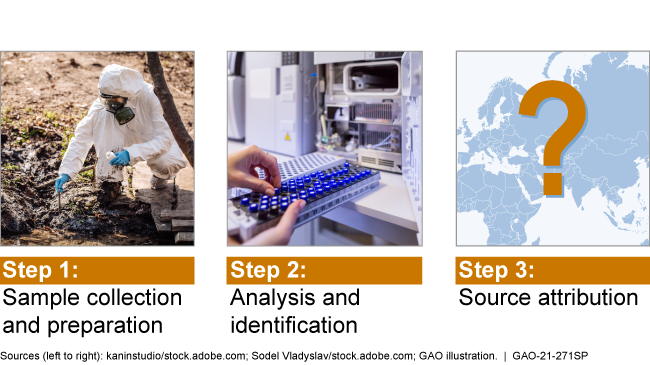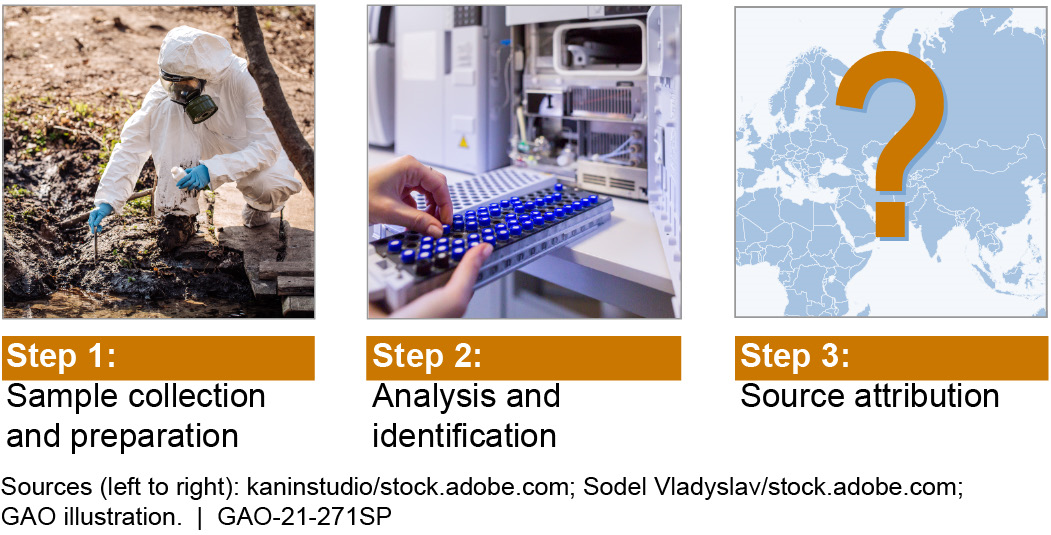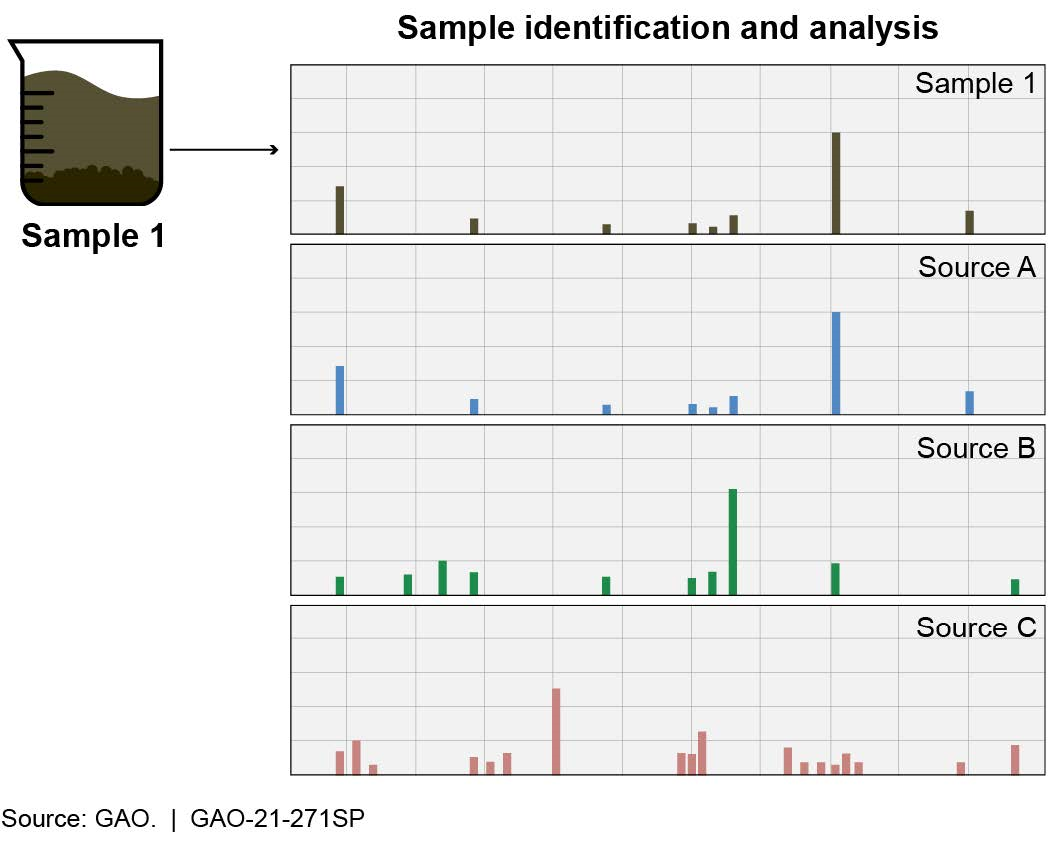Science & Tech Spotlight: Tracing the Source of Chemical Weapons
Fast Facts
The forensic chemical attribution process seeks to trace chemical agents used in attacks. Investigators take a sample of the agent from a victim or site, and then analyze its physical and chemical properties. The data can be used to identify a "chemical fingerprint," which could provide information to investigators about how the agent was made.
Investigators could use this data to match and trace the agent to its source to help find and prosecute attackers, impose sanctions, or deter future attacks. We explored the opportunities and challenges to implementing the forensic chemical attribution process.
The forensic chemical attribution process.

Highlights
Why This Matters
Some governments are suspected of using chemical weapons despite international prohibitions under the Chemical Weapons Convention. For example, sarin and VX nerve gas have been identified in attacks. Most recently, Novichok nerve agent was used in 2020. Technologies exist to identify chemical warfare agents and possibly their sources, but challenges remain in identifying the person or entity responsible.
The Technology
What is it? According to the Global Public Policy Institute, there have been more than 330 chemical weapons attacks since 2012. Such attacks are prohibited under the Chemical Weapons Convention. A set of methods called forensic chemical attribution has the potential to trace the chemical agent used in such attacks to a source. A set of methods called forensic chemical attribution has the potential to trace the chemical agent used in such attacks to a source. For example, investigators could use these methods to identify the geographic sources of raw materials used to make the agent, for example, or to identify the manufacturing process Such information can aid leaders in deciding on whether or how to respond to a chemical weapons attack.

Figure 1. Forensic chemical attribution process
How does it work? Forensic chemical attribution is a three-step process, though the third step is being developed (see Fig. 1). First, a sample is taken from a victim or the site of an attack. Second, the sample's chemical components are analyzed and identified (see Fig. 2), either at a mobile lab or at one of 18 authorized biomedical labs worldwide. Common identification methods are:
- Gas chromatography, which separates chemical components of a mixture and quantifies the amount of each chemical.
- Mass spectrometry, which measures the mass-to-charge ratio of ions (i.e., charged particles) by converting molecules to ions and separating the ions based on their molecular weight.
- Nuclear magnetic resonance (NMR), which can determine the structure of a molecule by measuring the interaction between atomic nuclei placed in a magnetic field and exposing it to radio waves. NMR works on is the same principle as magnetic resonance imaging (MRI) used in medical diagnostics.
In the third step—still under development—investigators use the data from the forensic chemical identification and analysis and identification methods from step two to develop a "chemical fingerprint." The fingerprint can be matched to a database of information on existing methods or known sources to identify chemical agents (i.e., Source A matching Sample 1 of Fig. 2). However, a comprehensive database containing complete, reliable data for known agents does not exist.
How mature is it? Forensic chemical analysis and identification (i.e., Step 2 of Fig.1) is mature for known chemical agents. For example, investigators determined the nerve agent sarin was used in an attack on civilians in 2017. The methods can also identify new agents, as when investigators determined the chemical composition of the Novichok nerve agent after its first known use, in 2018.
Forensic chemical analysis and identification methods are also mature enough to generate data that investigators could use as a "chemical fingerprint"– that is, a unique chemical signature that could be used in part to attribute a chemical weapon to a person or entity. For example, combining gas chromatography and mass spectrometry can provide reliable information about the chemical components and molecular weight of an agent. To achieve Step 3, scientists could use this these methods in a laboratory experiment to match impurities in chemical feedstocks of the weapon to potentially determine who made it. In an investigation, such impurities could indicate the geographic origin of the starting material and the process used to create the agent.

Figure 2. Example of forensic chemical identification and analysis, showing a match between Sample 1 and Source A.
Opportunities
An effective international system for forensic chemical attribution can open up several opportunities, including:
- Defense. Knowing the source of a chemical agent could help nations better defend against future attacks and, when appropriate, take military action in response to an attack.
- Legal response. Source attribution may provide information to help find and prosecute attackers or to impose sanctions.
- Deterrence. The ability to trace chemical agents to a source might deter future use of chemical weapons.
Challenges
-
Chemical database. Creating a comprehensive international database of chemical fingerprints would require funding and international collaboration to sample chemicals from around the world.
-
Finding perpetrators. Matching a chemical to its sources does not reveal who actually used it in an attack. Almost all investigations require additional evidence.
-
Samples. Collecting a sufficient sample for attribution can be challenging, as can storing and transporting it using a secure chain of custody—potentially over great distance—to one of the 18 authorized biomedical labs worldwide.
-
International cooperation. Lack of cooperation can delay investigations and may compromise sample quality. Cooperation is also essential for creating an international database.
-
Standardization. Attribution methods are complex and require standardized, internationally accepted protocols to ensure results are reliable and trusted. Such protocols do not yet exist for attributing a chemical weapons attack.
Policy Context and Questions
The following questions are relevant to building an effective, trusted system for tracing attacks using forensic chemical attribution:
-
How can federal agencies promote and contribute to the international standardization of scientific methods for forensic chemical attribution? Which agency or agencies should lead this effort?
-
How can the international community create and implement a framework for cooperation and trust in forensic chemical attribution?
-
What actions could promote or incentivize creation of an internationally accepted database of unique chemical fingerprints for attributing chemical agents to their sources?
-
What can be done to fully identify and address the scientific and technological gaps in current capabilities for attributing a chemical agent to its source?
For more information, contact Karen Howard at (202) 512-6888 or HowardK@gao.gov.
